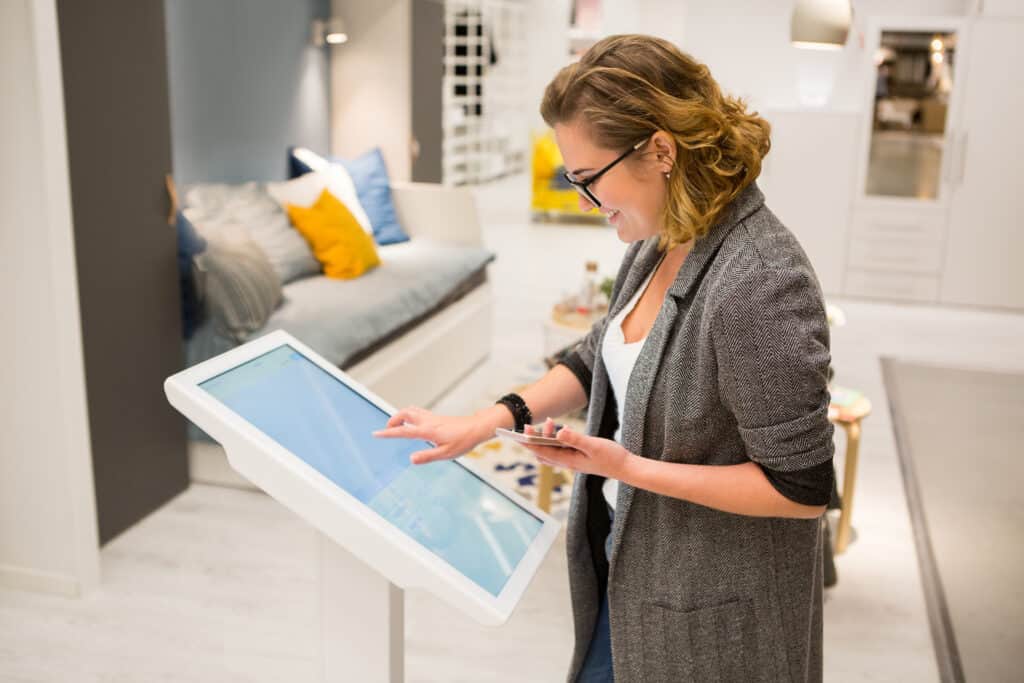Retail is an art. It’s common to see stores with similar locations, assortments, and prices drive shockingly different revenues. What is it that makes customers choose one store over others that appear so similar? When stores are competitive on the basics, customers choose based on how the retail experience makes them feel. The only pot shop in town could throw a cash register on a display case and turn a handsome profit. The best stores in crowded markets have to work hard to stand out, but they are usually rewarded with 2-3x the average sales and 5-10 points of extra profit. In retail, it pays to be an artist and an innovator.
Most cannabis retailers still follow the original dispensary retail model where each customer approaches the sales counter and is guided through the process by a single budtender. As recreational chains replace medical dispensaries, there has been a growing trend of well-funded retailers opening beautifully merchandised stores designed to encourage self-shopping and discovery. These new strategies offer exciting potential to drive sales while limiting labor, but many self-shopping strategies are failing to deliver a compelling retail experience.
In my last article I explored the origins of the guided-shopping dispensary model, the trend towards self-shopping to drive profitability, and the unique advantages, challenges, and efficiency impacts of each retail strategy. (For more, read Cannabis retailers abandon the dispensary model in search of greater profits.) This follow-up will explore the most common self-shopping mistakes, fears, and fallacies in cannabis retail. Finally I’ll conclude with how and where self-shopping is being done right with incredible results.
Common mistakes
The four most common strategies for enabling customers to self-shop are menus, digital kiosks, featured product displays, and impulse displays. These are good ideas, but all fall short of delivering an optimal experience. Customers can only self-shop effectively when they can view the entire product assortment with sufficient price, size, and other information to answer the most common questions and allow comparison between similar products.
Menus are incredibly common in cannabis retail. Unfortunately, I’ve yet to see a menu that provided sufficient information for a customer to make an informed purchase decision. Whereas restaurant menus offer a handful of options complete with descriptions and ingredients that enable customers to compare options, most cannabis menus simply offer a list of product names and prices.
Paper menus are easy enough to read, but are difficult to keep current as the assortment changes, and very time consuming to maintain (unless automated). Digital menu displays can be integrated with your POS inventory and updated automatically.
Unfortunately, most cannabis retail assortments are far too large to fit on the typical 2-3 wall-mounted monitors. The most popular approach is to shrink the font size and then scroll or flip through the product options and categories. The rule of thumb in overhead menus is to use at least a 30pt font for product listings. Most cannabis menus are closer to 15-20pt, and are therefore unreadable for customers who aren’t standing directly in front of the sales counter (defeating the objective of enabling self-shopping). Even then, if all that’s visible is product name and price, it’s a poor retail experience.
Digital kiosks, tablets, and online menus have become increasingly common as most markets now allow online ordering for in-store pickup (a.k.a. curbside pickup or click-and-collect). I’ve seen these tools used with great success, but very few retailers populate their digital menus with enough product information (pictures, pricing, size options, product descriptions, THC and terpene percentages, etc.) to deliver a compelling shopping experience that rivals either a normal e-commerce experience or a well-merchandised retail store. Even when all of this information is provided, customers overwhelmingly prefer physical product displays to standing in-store and clicking through digital product pages.
Featured product displays are a great idea and a retail best practice. Unfortunately, unless the entire product assortment is visible, customers lack the context and confidence to make a purchase decision. I appreciate seeing that a product is featured, but before buying I really want to understand what other options are available and at what price. Is this the only product on sale or the only one featured? Unless all product options within a category are displayed, most customers simply bypass featured displays and proceed directly to the sales counter to talk with a budtender.
Impulse displays are designed to increase basket size by presenting customers in line or at the point-of-sale counter with options to add onto their purchase. This is another retail best practice, but impulse displays are a poor replacement for traditional product displays. It’s awkward to browse backward and forward along a display when a line of customers is standing directly in front of it. Point of purchase displays are effective for add-ons, but if you can’t look over the display until you’re standing in front of the budtender, it’s not an efficient or comfortable self-shopping environment.
In most cannabis stores today, customers must wait to browse the assortment until they are at the sales counter and standing in front of a budtender. This is a wildly inefficient process that results in high labor costs and low customers satisfaction.
Common self-shopping fears and fallacies
Many cannabis entrepreneurs in new markets expect the majority of their traffic will be curious new consumers seeking basic product education. In reality, knowledgeable customers outnumber curious novices by a wide margin even in the first few weeks of a new market. Even in newly legal markets, most customers have been consuming cannabis for years. In short order, confident regulars who prioritize value and convenience will vastly outnumber curious novices seeking expert consultation.
One fear about shifting to a self-shop retail model I’ve heard again and again is that customers will be unable to remember what they want to purchase long enough to ask for it at the sales counter. This fear is overblown. Cannabis data insights company BDSA reports that average transaction sizes across markets ranges between 1.1 and 2.4 items per transaction. I’ve seen a half dozen strategies deployed to help customers remember what they want to purchase, from pen and paper, to product cards, to empty packaging that can be displayed and picked up like any normal retail product. The vast majority of customers ignore these, and have no trouble remembering the 2-3 items they want to purchase.
Self-shopping done right
After a couple years of trial and error with a chain of stores in the Seattle market, my team landed an approach to self-shopping that resonated with customers and proved manageable for the stores. In response to the limits of regulations and cannabis packaging, we redesigned stores to allow customers to browse the entire assortment, compare products, and make purchase decisions independently. At its core this process included:
- Install enough merchandising fixtures to securely display the entire product assortment AWAY from the Point of Sale. Create different fixtures for different types of products to highlight and differentiate.
- Design signage templates for each product category, including way-finding, brand-level detail, and individual product cards with detailed product information, price, and size options. (Templates allow signage to be customized and printed in-store while retaining a professional appearance.)
- Draft custom copy for most products in the assortment for use in online product pages and in-store displays (similar to shelf-talkers in a wine store).
- Employ low-cost cashiers to quickly process transactions, and a smaller team of highly compensated consultants/educators/specialists trained to answer more detailed product questions.
In the years since, I’ve seen this basic approach replicated in successful retailers across North America, particularly in Canada where federal legalization and easier access to capital is spurring the growth of national retail brands. This strategy for creating a self-shopping retail experience is likely to be prohibitively expensive for the smallest retailers and incredibly profitable for larger chains. The cost of designing and producing assets for one store is roughly the same as the cost for 5 or 10 stores. When broader assortment strategy is set at the corporate office, and marketing and merchandising assets are created centrally for a chain of stores, the cost of developing and maintaining a self-shopping environment ends up being a fraction of what it costs to guide each customer through the entire shopping process during each visit.
It should be self-evident that the best possible retail experiences allow customers to shop in whatever way they prefer. I believe the guided shopping experience is the most common approach to cannabis today ONLY because it is easier to design, maintain, manage, and execute. As regulations in new markets permit larger brands and retail chains, retail investments are growing quickly and driving a shift toward self-shopping models that drive sales and customer satisfaction while reducing costs.
The best retailers put tremendous thought into each step of the shopping experience and are rewarded with incredible sales and profitability. While retail at this level is an art, and larger players have obvious advantages, the basic principles of delivering a compelling retail shopping experience can be adopted to improve results for retailers of any size.





2 thoughts on “How to actually drive higher profits with the self-shopping model”
Pingback: How to stand out in the store: brand kiosk design tips from the experts - MJ Brand Insights
Pingback: Industry pioneer Jesce Horton joins advisory board of MJ Unpacked - MJ Brand Insights